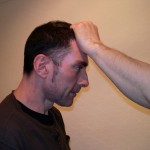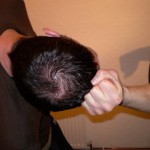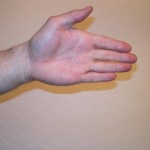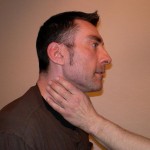Sometime in the mid to late 18th Century, a tribute ship set sail from Okinawa to China, carrying Okinawa’s taxes to the Chinese government. Late at night as the ship approached China’s Fuzhou harbour another ship approaches under cover of darkness and attacks. These are ruthless pirates, intent of killing the crew and stealing the whole ship complete with cargo. Neither ship has cannons, so the pirates board the Okinawan ship and desperate hand to hand combat ensues.
But unbeknown to the pirates, this ship carries a special passenger who is very significant to the development of Karate; the great Karate master, Satunushi “Tode” Sakugawa.
Sakugawa had been trained in what is now a largely lost art of night fighting and try as they might, the pirates were unable to get a good hold of him. Sakugawa single-handedly throws most of the pirates into the sea. However, being outnumber he grabbed the last few pirates and jumped overboard, taking them with him and saving the ship.
Chinese harbour patrols pick them out of the water and arrest the pirates and mistaking Sakugawa for one of them they arrest him too. Fortunately Sakugawa is able to learn enough Chinese to explain and is later released.
So apart from being a good story over a pint of beer, why is this of interest to us today? Well firstly Sakugawa was the teacher to the great Okinawan Karate master, Sokon Matsumura, who was the prime mover in developing linear power, which is so prevalent in Karate today.
So did Sakugawa have a role in developing linear power?
No, historians indicate apparently not!
Rewind to several years earlier; Sakugawa was trained in the Okinawan art of Tode (which he included into his own name) and later (more importantly for us) he learnt White Crane Kung Fu.
As a young man of 23, Sakugawa, confident in knowledge of Tode, thought it would be funny to throw a visiting Chinese dignitary, Kong Su Kung into a stream. Kong Su Kung however, being a master of White Crane Kung Fu easily outmanoeuvred his youthful attacker and Sakugawa was forced to apologise. Kong Su Kung was a forgiving man and offered to train the spirited young Sakugawa. At that time, White Crane was an exciting new art, not really known to the Okinawans. This is where we come to the important part for us; Kong Su Kung introduced to Sakugawa (and hence to Okinawa) to the White Crane principle of “hiki-te”.
Hiki-te is Japanese for the pull back hand - the hand that comes back to the hip whilst a technique is being executed with the other hand. It is hard to imagine how Karat would look today without hiki-te. Being of Chinese origin it is of course also present in many Chinese martial arts. It is however quite unique to traditional Oriental martial arts and is not really seen in martial arts from other parts of the world.
Hiki-te is often derided by many people from other fighting systems who feel that these traditional Oriental arts are stylistic and not very practical. They ask why we leave such a big hole in our guard by pulling the hiki-te hand back to the hip, rather than leaving it up as a guard like boxers do when they punch? Many traditionalists answer that it is to gain maximum power from the technique. This is never a convincing answer, especially when so many other fighting forms (boxing, kickboxing, Krav Maga etc) can generate a lot of power without pulling back to the hip. Unfortunately, most people miss the point be they boxers, kickboxers; or surprisingly, the same traditional martial artists who do actually practice hiki-te.
So what is the point Charlie?
I’m glad you asked me that. In Sakugawa’s day, most military tactics were based on daytime encounters, yet personal self defence would often be based on night time encounters (as that’s when most muggers, robbers etc would attack). With lack of street lighting back then, night encounters would generally be much darker than today (as we mostly live in towns/cities with street lights and lights from nearby buildings). Night fighting tactics would need to be different back then because it is hard to hit a target you cannot see properly. Therefore grappling techniques would be far more valuable. Many Chinese styles include sensitively training with what they call push hands or sticky hands. Imagine that you have to feel for an opponent in the dark. As soon as you contact an arm, you grab it, twist it and pull back to your hip pulling your opponent off balance (hiki-te). At the same time, you strike with the other hand, as now you know exactly where he is, even if you can’t see him properly.
Sakugawa was taught night fighting by Kong Su Kung and was introduced to the (then new) principle of hiki-te. Is it effective? Well I don’t know about hiki-te in isolation, but obviously White Crane Kung Fu was effective by the way that Sakugawa defeated a crew of pirates practically single handed.
As an aside, many Chinese styles primarily use circular technique (using centrifugal force to generate power) which is good for grappling/throwing and this would have been the way that Kong Su Kung would have taught Sakugawa. Sakugawa’s student, Matsumura developed linear technique (powered by forward body momentum) which is not quite so good for grappling. Why would Matsumura make these changes? As chief bodyguard to the King of Okinawa, Matsumura’s main “battlefield” would have been the well lit Shuri Palace, where night fighting techniques would have been less important. As Matsumura and his men could be outnumbered, he would have been mainly interested in releases from grabs/holds/controls and in being able to put the opponents down as quickly as possible. This means less emphasis on grappling (which can be a bit slow for multiple opponents who can all clearly see you) and more emphasis on powerful strikes that can incapacitate opponents very quickly. However, even with this change of requirements and the very fundamental shift in underlying principles (which really sets Karate styles derived from Matsumura’s lineage apart from its Kung Fu roots), he still kept the hiki-te intact, so he must of seen a lot value in it, even outside of the night fighting scenario.
(Note: Just out of interest, Goju Ryu Karate and its derivatives are not from Matsumura’s lineage and are more akin to Kung Fu with emphasis on circular technique. Goju Ryu is also believed to have been largely derived from White Crane Kung Fu and uses hiki-te too).
So why do so many people have so much trouble recognising hiki-te’s “grappling” applications in traditional Oriental martial arts?
It’s largely because we usually look through the lens of sport martial arts. In most traditional systems, we are actually banned from grabbing in competition, so we look at our arts mainly from a striking, punching, kicking point of view. Most traditionalists are not used to looking for grappling applications. However, for night fighting when you really cannot see your opponent very well, grappling would be the cornerstone of self defence!
Part of the reason that kickboxing was created in America, was because people had trouble seeing the value of traditional martial art techniques (still the case for many today). It made much more sense for a public raised with boxing to put on the gloves, include the new (to the West) kicking techniques, and treat it like a boxing match. As Karate had already been heavily dumbed down at this point for many reasons (maybe a subject for another article), nobody was there to teach what the movements where really for.
Back to Sakugawa. He made up a kata in honour of his teacher and named it after him. But in the Okinawan language, the characters for which made up Kong Su Kung’s name are pronounced Kusanku. When Gichin Funikoshi took Karate to Japan generations later, he used the Japanese pronunciation of Kanku (hence the katas Kanku Dai & Kanku Sho). To this day, Kusanku/Kanku is still a very central kata in many styles of Karate. When people first learn it, they often comment on how close it is to many of the basic Heian set of katas (also known as Pinan in some styles). The Heian/Pinan katas were created by Master Itosu, who was Matsumura’s student, so Itosu would have learnt Kusanku.
So Sakugawa’s legacy is very strong even today, not only in the beautiful kata that he created, but also its influence on the now very standard basic learning katas (Heian/Pinan) and the all important inclusion of hiki-te, which has over time been included in every other kata and almost every hand technique.
So let’s have a closer look at hiki-te. It is performed different ways in different styles. The Shotokan way is, with the arm extended, make a fist (palm down), twist and pull back. However, some styles make a fist, pull back, and twist only as the hand reaches the hip. I believe that the Shotokan way, twist, then pull method was the original way. This is purely guesswork, but I believe that the fist, pull, twist method came along later when the people were only focusing on punching and not on the grappling applications.
Let me explain why I think this. First of all, when you make a fist in a kata or a basic movement, it can either be for striking or to represent grabbing. If you accept that you are grabbing, then the hiki-te movement has to be pulling something (opponent’s body parts)! Now have a training partner extend their arm with the palm facing down. Grab the top of their wrist with a cross grip (your right to their right or your left to their left). If you both pull, (assuming that you are similar in strength) then is should be quite even and neither of you will have much advantage. Note that your main pulling muscle in the arm is the bicep (the triceps are used for pushing). Now grab your partner’s wrist again in the same way and this time . . . . twist. You’ll find that your bicep goes into the contracted position and your partner’s bicep is now stretched. This means that your bicep is in its optimum pulling position whilst your partner’s bicep is in a very much weakened position. You now have the advantage over a partner of equal (or even greater) strength and you can pull back to your hip with relative ease.
Now the first time you try this, it might feel a bit awkward. Furthermore, if your partner resists your twisting motion it will be difficult to twist their wrist. But bear in mind that when you are training, your partner knows what you are doing. If you are able to apply this technique quickly on an unsuspecting opponent, then you can have their wrist twisted before they realise what is happening, by then it’s too late - for them.
Now let’s look at applying hiki-te with some of our techniques. Well pulling them into a prone position whilst punching is quite obvious. Having gotten them into a prone position, you can try to talk so sense into them. If that does not work then you can punch some sense into them!!
If we look at Gedan Barai (downward block), as we perform hiki-te we stretch out the opponents arm as we pull it back, we can then apply the Gedan Barai to bear down onto their triceps and we have an arm lock.
The same works with a Soto Uke (outside block). As with the Gedan Barai example, we can extend the opponents arm while twisting and pulling it, then we can apply pressure to either the elbow joint or triceps. Be careful with this application as it can either be an arm lock, or (if done a bit more forcibly) it can break the arm.
With an Age Uke (rising block), if you grab your opponents upper arm or sleeve, hiki-te can used to pull the opponent forward and down, whilst our “blocking hand” strikes under the chin or into the neck.
Now you may be wondering, if this is part of a system designed to be used for night fighting in a time when it really was too dark to see your opponent, is it still valid today? I would have to say emphatically, YES. Most moves in traditional Oriental martial arts are designed to be multi-functional. In most situations today, street lighting (or even lighting from surrounding buildings) will allow you to see your attacker. If somebody is threatening you whilst pointing or shaking their fist, or if they try to grab you, or if they punch and you block; in each case you can quickly grab their wrist, then apply your hiki-te. We practice pulling hiki-te back very fast, so when you do that to an unsuspecting opponent, it jerks them off-balance. It is a human instinct that we automatically try to recover balance before anything else. So before they think about defending themselves from your follow up technique, or even hitting you back; they will be trying to regain their balance. That gives you that vital split second when they are at your mercy!
For those who are into alternative applications, you’ve probably seen the example above already. But there are other ways to use hiki-te as well. You can really more or less grab anywhere and use hiki-te. Even if you just grab the clothing and pull, you can unbalance them long enough to get a good technique in.
Now just to be clear, hiki-te on its own will not be a fight finisher. But it is good for setting the person up for more punishment and for a technique that could be the fight finisher.
Even grabbing somebody’s hair! If you grab and twist, you maintain the pulling pressure to the hair. Without the twist, you cannot maintain the pulling pressure so well unless you keep pushing and pulling their head around. With the twist, you maintain the pull on the hair causing pain and distraction; then pulling back to your hip pulls them right of balance where you can strike with relative impunity. Furthermore, the twisting motion pushes your small knuckles into their head, which can create even more discomfort and distraction for them. [See Fig’s A, B & C below]
In some styles of Kung Fu, they do a lot of flesh grabbing. By this I mean, just grabbing a surface layer of skin (not necessarily limbs, wrists or muscles). When we first learn to make a fist, we close up our outer set of knuckles (nearest the finger tips), then we close the larger knuckles (where the fingers join the hand). [Fig’s D, E & F below] Imagine you are locked in a grapple with somebody, try (carefully!!) with a partner putting your hand against the side of their body just below the ribs. Close up the first set of knuckles and trap some skin (doesn’t have to be much), then (carefully) close the rest of the hand, twist and pull. It can be quite painful.
You can experiment on different parts of the body. Obviously it will not be so easy with a very lean person, but even they will have some surface flesh to grab. This kind of flesh grab can be especially effective to the lower side torso, under the upper arm (triceps area), neck and groin. But experiment with it and you’ll be surprised how versatile it can be. [Fig’s G, H & I below]
Just be aware that this is a set up, not a fight finisher. Also with flesh grabs, if your attacker is drunk, high on drugs or very adrenalised, they will not feel it as much as when you practice in the safety and comfort of your warm and friendly dojo, so be prepared to do it much harder if you ever have to do it for real.
So next time somebody asks you why you pull your hand back the hip and leave yourself “exposed” rather than keeping your guard up, whisper a little thank you to Satunushi “Tode” Sakugawa and tell them.











